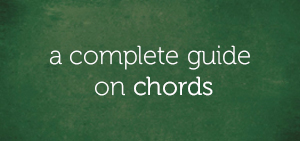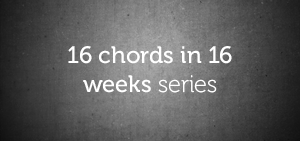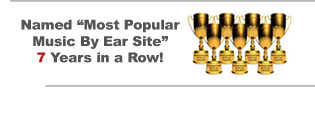In today’s post, I want to introduce you to the pedal point.
Sure, playing cyclical (or circular) progressions that move in fourths and fifths sounds harmonically engaging and exciting. And music loves to move in this manner. But there are musical situations where less is more. These are situations where you don’t necessarily need to change bass notes per chord. In this situation, one bass note is used over several chords.
Here’s what I mean:
You can play the primary chords (Chords 1, 4 & 5) over a C bass note as opposed to the traditional practice of changing bass notes per chord.
C major / C bass
F major / C bass
G major / C bass
F major / C bass
The C bass note is called a PEDAL POINT or PEDAL NOTE.
Pedal Point – Defined
A pedal point (or note) is a sustained tone, typically in the bass, that is played while a foreign harmony or chord is sounded on the right hand. Pedal points are usually on either the Tonic (“Do”) or the Dominant (“Sol”), which are the first and fifth tones of the scale, respectively.
In the key of “C,” we’ll look at a simple progression with “C” as the pedal tone.
C major / C bass
D major / C bass
F minor / C bass
C major / C bass
How did that sound?
“Not Bad? Sounds discordant.”
“Nice! I’ve heard it in some hit songs.”
The ‘Beauty’ of Discordance?
The Pedal Point (C) is conflicting with some chords in this progression.
But that’s the idea!
Pedal Points are to be played against foreign chords or harmony as well as related ones. That’s how pedal points work.
Imagine having an F♯ Major triad over C:
The chord above can be notated as F♯/C which means F♯ over C. C and F♯ are foreign keys (no relationship). C and F♯ Major triads do not have any chord tones in common.
If we form intervals between C and the chord tones of F♯ Major triad, we’ll have augmented intervals (which are also called dissonant intervals [when dissonant intervals are played, the notes sound disagreeable with a {high or low} degree of unpleasantness]).
Here are the harmonic environments created by Augmented Intervals formed from this bass note versus foreign harmony:
C-F♯ is an Augmented Fourth (aka – “Tritone”). This interval was known as diabolus in musica (meaning “Devil in Music”) in medieval times (AD 400-1400). It was once a forbidden interval! Playing it in church could put you at the risk of being excommunicated.
C-A♯ is an Augmented Sixth. This interval creates Augmented Sixth chords. There are three Augmented sixth chords (Italian Sixths, German Sixths and French Sixths). Augmented Sixth chords resolve to dominant chords (I believe the duo are cousins). Not much is known about this interval of Augmented sixth chords outside classical music because the difference between an Augmented sixth chord and a dominant seventh chord is spelling.
For example:
A♭ Dom7 and A♭ Augmented German sixth have everything in common except spelling:
A♭ Dom7 has a G♭ note:
A♭ German Sixth has an F♯ note:
C-C♯ is an Augmented Unison. This is another dissonant interval. In tonal music, this is the shortest interval.
Notwithstanding the discordance associated with the bass note under foreign harmony, we can enjoy pedal point progressions because they give us the liberty (maybe I should say license) to connect any foreign harmony with the Tonic or Dominant as the bass note. That’s a harmonic opportunity not just to experience but to explore the beauty of discordance.
Pedal Point – Application
Alright, let’s take it up a step further by applying this pedal progression to a known Gospel song. With the same song, the same pedal, but different chords (reharmonized).
One thing we
Ask of you
One thing that
We desire
Wow! Hope you’re not just reading this? You better stop reading this and plunk down the chords – you’ll be amazed.
Playing pedal note progressions is a litmus test to the fact that less is more. We’re achieving more with a static bass line over related and foreign harmony. Pedal point progressions are an integral part of contemporary praise and worship songs.
P.S
There are lots of songs that can fit in perfectly into this pedal point progressions. Let me give you one more example:
Hosanna
Hosanna
Hosanna in the high-
-est
Pedal Point – Final Tips
We’ve covered a lot on Pedal Point Progressions (“P-Cube”). I’ll be back with some mind-blowing pedal point progressions in future posts. Before then, don’t forget to:
INVERT THE CHORDS. The pedal point (or note) is mostly played against triads. These triads have their respective inversions (first and second inversions). A pedal point chord can sound better when inverted. If possible, let the melody note of the chord be the melody note of the song you’re playing.
KEEP IT SIMPLE. Most times, you don’t really have to go far into a foreign harmony that you can’t resolve. Remember to use your license properly. To avoid being stuck in a discordance you can’t handle, keep it simple.
Until next time.
Chuku Onyemachi
Latest posts by Chuku Onyemachi (see all)
- The Formation Of Diminished Seventh Chords Used To Be Challenging Until I Did This
- How To Form Seventh Chords In Two Shakes Of A Dog’s Tail Using Third Intervals And The Circle Of Fifths Chart
- I Played The 13sus4 Chord And This Happened…
- How To Build Seventh Chords Like An Architect Using “Foundation And Structure” Concept
- This 4-Week Plan Will Help You Master All The Major Scales







Comments on this entry are closed.